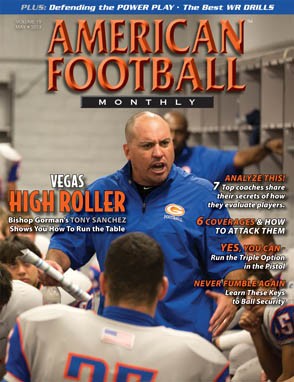Article CategoriesAFM Magazine
|
Emphasizing Ball Security – Mastering the five points of contact will help keep your runners from fumblingby: Chad MillerRunning Backs Coach, Northwestern College (MN) © More from this issue Mastering the five points of contact will help keep your runners from fumbling dropping the ball. When teaching ball carriers about ball security, we talk about the five points of contact. The first point relates to our nickname which is the Eagles, so I use the term “Eagle Claw” for the point of the football. The second point of contact is the forearm and the third is the bicep. Both are used to secure the outside part of the ball to the middle of the body which leads to the fourth point of contact which is the chest. The fifth point is keeping the elbow down, which raises the tip of the football to the position “high and tight”. The wording of each of these points may change from person to person, but the basic idea is to make these terms simple and understandable for your own players. Why keep the ball up ....The full article can only be seen by subscribers.
|
|
|||||||
| HOME |
MAGAZINE |
SUBSCRIBE | ONLINE COLUMNISTS | COACHING VIDEOS |
Copyright 2025, AmericanFootballMonthly.com
All Rights Reserved





